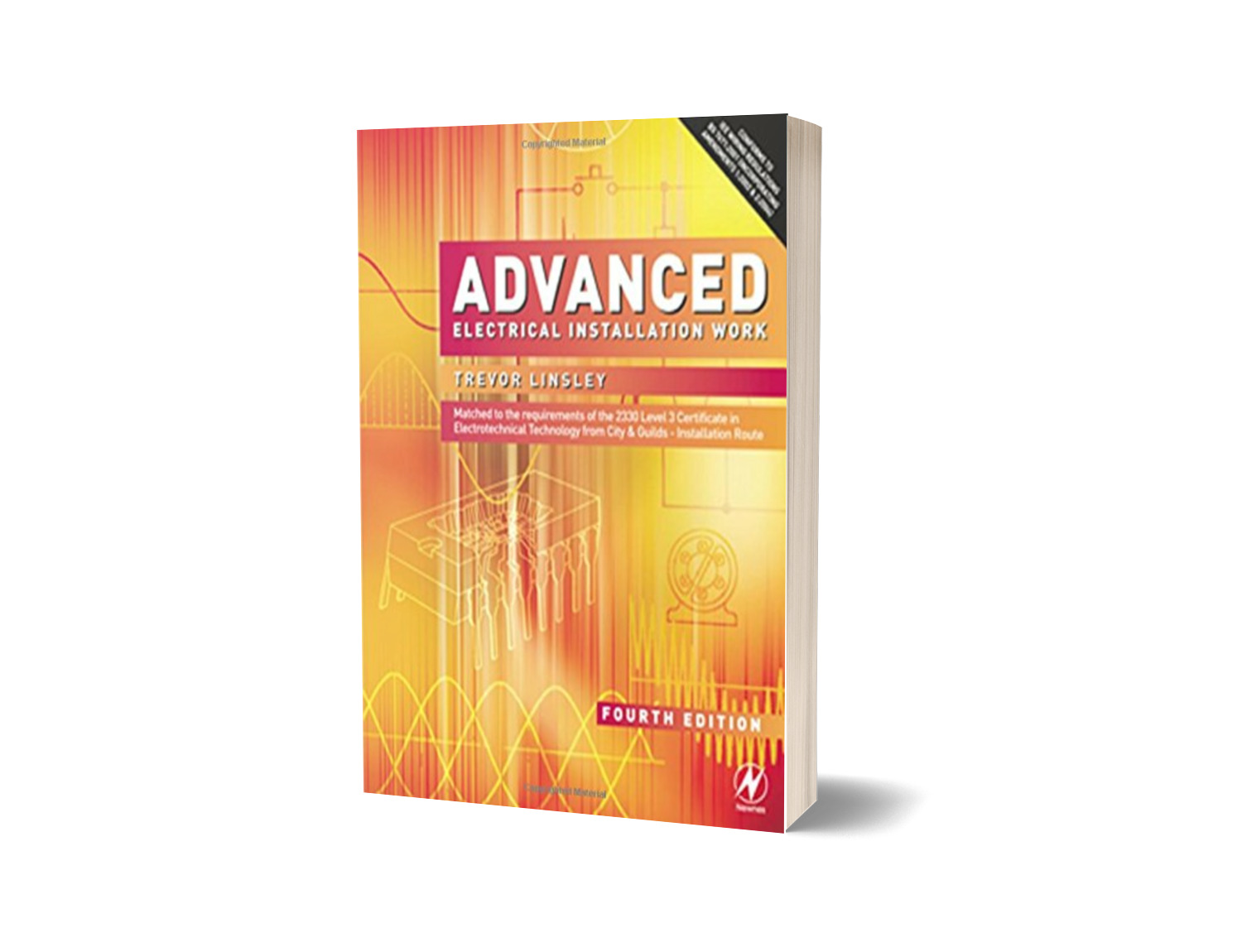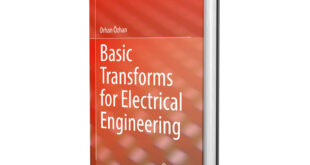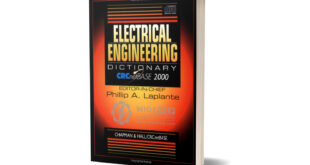The Overview
Many students have benefited from Advanced Electrical Installation Work in order to achieve in City & Guilds electrical installation awards. This book, presently in its fourth edition, received a thorough overhaul in order to provide an exact match to the Installation route criteria of the 2330 Level 3 Certificate in Electrotechnical Technology. It is also a necessary purchase for students pursuing the Level 3 NVQs in Electrotechnical Services (Electrical Installation – Buildings & Structures).
The 2330 Certificate’s core unit as well as occupational units 2 and 3 in Installation (Buildings & Structures) are all comprehensively covered in Trevor Linsley’s resource for the certificate. Electronic Components, a crucial component of electrical installation work, is covered in a separate chapter that serves as a reference.

This wonderfully illustrated booklet’s worked examples and problems with solutions make for a user-friendly student manual that’s perfect for independent study. New sections on health and safety, employment rights and responsibilities, personal protective equipment, and safety regulations have been introduced to match the 2330 Certificate’s emphasis in these specific areas. The material completely complies with the 2004 IEE Wiring Regulations BS 7671:2001 (incorporating Amendments 1:2002 & 2:2004).
The best-selling book in the category of electrical installation was written by Trevor Linsley, a former senior professor at Blackpool & Fylde College and the head of the NVQ Assessment Center.
kit for educators, 0750669616
This bundle provides the necessary collection of teaching resources and photocopyable handouts for the prerequisite units of the 2330 Certificate in Electrotechnical Technology from City & Guilds, with a chapter-by-chapter match to the units of the electrical installation pathway at Levels 2 and 3. It should be used with the students’ textbooks, together with Basic Electrical Installation Work and Advanced Electrical Installation Work. The basic curriculum for the 2330 syllabus, the two occupational units for Level 3, and the occupational unit for the Level 2 pathway in electrical installation are all covered.
The newly revised edition covers the complete 2330 Level 3 Certificate in Electrotechnical Technology’s Installation route and provides additional treatment of Electronic Components, a crucial area of study for electrical installation.
* Covers subjects that were mentioned in the most recent specifications for the scheme: Regulations pertaining to personal protective equipment, health, and safety
* Adopting the most recent IEE Wiring Regulations, BS 7671:2001, in its entirety.
Health and safety and electrical principles 1
Introduction 1
Health and safety at work 1
The Health and Safety at Work Act 1974 2
The Management of Health and Safety at
Work Regulations 1999 4
Provision and Use of Work Equipment
Regulations 1998 4
The Control of Substances Hazardous to
Health Regulations 1988 4
Personal Protective Equipment (PPE) at
Work Regulations 1992 5
RIDDOR 7
The Control of Major Accidents and Hazards
(COMAH) Regulations 1999 8
Dangerous Substances and Explosive
Atmospheres Regulations 2002 (DSEAR) 8
The Construction (Design and Management)
Regulations 1994 (CDM) 8
The Construction (Health, Safety and Welfare)
Regulations 1996 9
Building Regulations – Part P 2005 9
The Electricity Safety, Quality and Continuity
Regulations 2002 10
The Electricity at Work Regulations 1989
(EWR) 11
The IEE Wiring Regulations to
BS 7671:2001 11
Environmental laws and regulations 12
Environmental Protection Act 1990 12
Pollution Prevention and Control Regulations
2000 13
Clean Air Act 1993 13
Controlled Waste Regulations 1998 13
Waste Electrical and Electronic Equipment
(WEEE) EU Directive 2005 14
Radioactive Substances Act 1993 (RSA) 15
Dangerous Substances and Preparations and
Chemical Regulations 2000 15
Noise Regulations 15
The Noise and Statutory Nuisance Act 1993 16
Noise Act 1996 16
Noise at Work Regulations 1989 16
The Environmental Health Officer 17
Laws protecting people 18
Employment Rights Act 1996 18
Health and Safety (First Aid) Regulations 1981 20
Data Protection Act 1998 20
Prejudice and discrimination 21
The Race Relations Act 1976 (RRA) and
Amendment Act 2000 22
Sex Discrimination Act 1975 (SDA) 22
Disability Discrimination Act 1995 (DDA) 22
The Human Rights Act 1998 (HRA) 23
Enforcement Law Inspectors 23
In-house Safety Representatives 24
Safe and effective working practices 25
Quality systems 25
Investors in People (IiP) 27
Health and safety applications 27
VDU operation hazards 32
Manual handling 35
Personal Protective Equipment 36
Safety signs 38
Accidents at work 39
Fire control 40
First aid 42
Accident reports 45
Secure electrical isolation 46
Permit-to-work system 49
The world of work 50
Good customer relationships 50
Changing work patterns 51
Electrical principles 52
Ohm’s law 52
Resistivity 53
Temperature coefficient 54
Resistors 54
Power and energy 58
Alternating waveforms 60
Magnetism 61
Electromagnetism 62
Electrostatics 67
Alternating current theory 73
Electrical machines 86
Direct current motors 86
Three-phase a.c. motors 90
Single-phase a.c. motors 94
Motor starters 95
Remote control of motors 97
Installation of motors 97
Motor maintenance 99
Power factor correction 100
Transformers 102
Transformer losses 103
Transformer efficiency 103
Transformer construction 104
Instrument transformers 106
Voltage transformers 106
Current transformers 106
Electricity supply systems 108
Low-voltage supply system 112
Industrial wiring systems 117
Cables 119 Installing cables 122
Protection of structures against lightning
(BS 6651) 132
Exercises 136
Inspection, testing and commissioning 146
The construction industry 146
The building team 146
The electrical team 147
Designing an electrical installation 148
Legal contracts 148
Management systems 150
On-site communications 155
Construction site – safe working practice 164
Electrical safety systems 165
Direct contact protection 165
Earth fault protection 167
Residual current protection 168
Isolation and switching 168
Overcurrent protection 169
Semi-enclosed fuses (BS 3036) 170
Cartridge fuses (BS 1361) 171
Miniature circuit breakers (BS 3871) 172
Fusing factor 173
Position of protective devices 173
Disconnection time calculations 174
Time/current characteristics of protective
devices 175
Discrimination 175
Earth fault loop impedance Zs 176
Size of protective conductor 178
Cable selection/calculation 179
Electrical testing 182
Moving coil instruments 182
Moving iron instruments 184
Damping 185
Making measurements 185
Range extension 187
Dynamometer wattmeter 189
Measurement of power in a three-phase
circuit 189
Energy meter 190
Tong tester 191
Phase sequence testers 191
Test equipment used by electricians 191
Test procedures 193
Live testing 194
Isolation of supply 194
Inspection and testing techniques 194
Certification and reporting 206
Safe working procedures when testing 206
Portable appliance testing (PAT) 207
Commissioning electrical systems 211
Exercises 211
Fault diagnosis and rectification 217
Symptoms of an electrical fault 217
Causes of electrical faults 217
Fault diagnosis 219
Wiring circuits 219
Designing out faults 227
Finding the electrical fault 227
Safe working procedures 227
Live testing 227
Secure isolation of electrical supply 227
Faulty equipment – to repair or replace? 229
Selecting test equipment 229
Special situations 230
Antistatic precautions 231
Avoiding shutdown of IT equipment 232
Damage to electronic devices by ‘overvoltage’ 233
Risks associated with high frequency or
large capacitive circuits 234
Presence of storage batteries 235
Safe removal of waste 236
Exercises 238
Electronic components 239
Electronic circuit symbols 239
Resistors 239
Capacitors 243
Inductors and transformers 247
Electromagnetic relays 248
Overcurrent protection 248
Packaging electronic components 248
Obtaining information and components 249
Semiconductor devices 249
Voltage divider 261
Rectification of A.C. 263
Smoothing 264
Stabilized power supplies 266
Electronic circuit assembly 266
Safety precautions 267
Hand-tools 267
Soldering irons and guns 267
Soldering 269
Desoldering 272
Circuit boards 272
Breadboards 275
Interconnection methods 275
Fault finding 277
Electronic test equipment 277
Test instruments 277
Analogue and digital displays 279
The multimeter 279
The ohmmeter 279
The cathode ray oscilloscope 281
Signal generators 283
Power supply unit 283
Mains electricity supply 284
Insulation tester 284
Logic gates and digital electronics 284
The AND logic gate 285
The OR gate 285
The exclusive-OR gate 286
The NOT gate 286
The NOR gate 287
The NAND gate 287
Buffers 287
Logic networks 287
Logic families 290
Working with logic 291
British Standard symbols 292
Exercises 292
Solutions to exercises 294
Appendices 296
Glossary 315
Index 325
Index
Download PDF Book
 widemep.com
widemep.com

